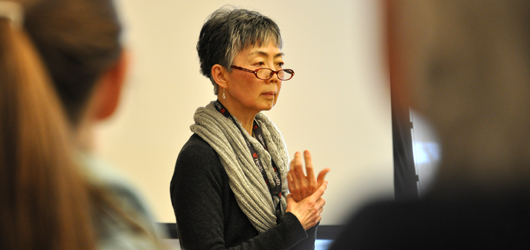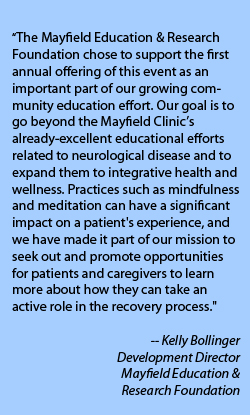
inaugural Resolve to Get Healthy symposium at the Kingsgate Marriott. Photo by Cindy Starr.
Geraldine Wu, MD, posed the question on her PowerPoint slide to a room packed with listeners eager for a calmer, less stressful life. Mind full? Or Mindful?
It was an ah-ha! moment.
 Those in attendance at last week’s “Resolve to Get Healthy” symposium at the Kingsgate Marriott were privileged to not only learn about mindfulness and meditation, but also to experience it under the gentle guidance of Dr. Wu, a Cincinnati psychiatrist and volunteer faculty member at the Center for Integrative Health and Wellness at the University of Cincinnati College of Medicine.
Those in attendance at last week’s “Resolve to Get Healthy” symposium at the Kingsgate Marriott were privileged to not only learn about mindfulness and meditation, but also to experience it under the gentle guidance of Dr. Wu, a Cincinnati psychiatrist and volunteer faculty member at the Center for Integrative Health and Wellness at the University of Cincinnati College of Medicine.
The event, a project of the UC Center for Integrative Health and Wellness, UC Health Integrative Medicine, and the Academy of Integrative Health and Medicine, was co-sponsored by the Mayfield Education & Research Foundation and UC Health.
Dr. Wu began by offering definitions of mindfulness:
• “Mindfulness is knowing directly what is going on inside and outside us, moment by moment,” according to Mark Williams, Professor of Clinical Psychology and the Wellcome Principal Research Fellow at the University of Oxford.
• Mindfulness means “To focus, on purpose, without judgment, on whatever is coming up in the mind, moment by moment,” according to Jon Kabat-Zinn, the creator of mindfulness-based stress reduction.
The Kabat-Zinn definition, Dr. Wu said, has three crucial elements. “The first is ‘on purpose,’ intentionality. Intention is a first step in cognition. Without intention, we are not able to learn. The second part is ‘without judgment.’ That is difficult, because it involves letting go of any kind of preconceived notion that you might have with whatever you’re involved in. This is a struggle for most of us, because it’s not how we’re taught. We are always taught to know what we are going to do, and to have a goal. And the third part, ‘moment by moment,’ means we pay attention to now rather than a goal for the future.”
Although there are different types of meditation and mindfulness, all focus on a few core disciplines: the cultivation of a less reactive awareness of emotions and the fostering of compassion, empathy and an altruistic perspective toward others and oneself.
Being mindful, Dr. Wu said, is difficult.
“Our mind is full of the past and the future,” she said. “It is easy not to be mindful of what’s going on. Mindfulness meditation is a process, not a goal. It is about being rather than doing. It is a practice that involves a continuing effort to concentrate. It is a serious cognitive process.”
The benefits of mindfulness and meditation – whose definitions overlap – have been linked to improved health:
• increased size of gray matter in the insula, which plays a role in perception, motor control, self-awareness, cognitive function, and relationships
• increased size of the hippocampus, the brain’s memory center
• decreased size of the amygdala, the locus of anxiety and fight or flight
• decreases in inflammatory markers, including cortisol and norepinephrine
“There is evidence that people who practice this have improved cognition,” Dr. Wu said. “When we concentrate on the present moment, we cannot be anxious, worried or distressed about other issues.”
One study found that patients with stage 1 and 2 breast cancer scored lower on a hostility scale after eight weeks of mindfulness-based stress reduction training, compared with study groups that received heightened nutrition or supportive care. The benefits were present at follow-up at 4, 12 and 24 months.
“We are accumulating evidence,” Dr. Wu said. “The medical community is paying attention.”
Keynote speaker Brad Jacobs, MD, MPH, medical director of BlueWave Medicine in California, said that meditation “deactivates rumination and worry.”
Richard Sears, PsyD, PhD, a Cincinnati psychologist who is affiliated with UC Health Integrative Medicine, said we don’t have to “carry the whole day” in our heads. “We have a sense that our life is always coming,” he said. “Sometime in middle life we stop and say, wait a minute, it’s not coming. This is my life. We need to plan for the future, but not to the exclusion of being in our lives today.”
— Cindy Starr